Modeling the Temperature Field in the Ground with an Installed Slinky-Coil Heat Exchanger
Abstract
:1. Introduction
2. Heat Fluxes on the Ground Surface
2.1. Convective Flux
2.2. Radiant Flux
2.3. Evaporative Flux
2.4. Thermal Balance on Ground Surface—The Analytical Solution
2.5. Examples of Time Courses of Heat Fluxes on the Ground Surface and Temperatures
3. Ground Temperature Field with an Installed Heat Exchanger
3.1. The Heat Flux Extracted from the Ground
- Heat is extracted from the ground only for space heating purposes.
- Outside the heating season, no heat is supplied to the ground.
- The average daily value of the heat flux extracted from the ground qGHE is assigned to each day of the year.
- The maximum value of the heat flux extracted from the ground is qmax.
- The number of days in the year hd for which heat is extracted from the ground for heating purposes is known; for the remaining days, qGHE = 0.
3.2. Application of the Ring Heat Source Model
3.3. Calculations and Simulations of Heat Transfer in a Slinky-Coil Ground Heat Exchanger
3.4. Overview of the Designated Ground Temperature Fields
- Heat consumption by the working medium flowing through the ground heat exchanger.
- Heat transfer between the ground surface and its surroundings.
3.5. Ground Temperature Calculation Methodology
- The undisturbed ground temperature T0 should be calculated according to Formula (2) as follows:
- Using the data from Table 1, calculate r1, r2, r3, and then Tsm (according to Equations (23)–(26));
- Calculate successively p1, p2, p3, and then Ps and As (according to Equations (28)–(32));
- Substitute the calculated values of Tsm, As, and Ps into Formula (2).
- In order to determine the temperature response , one must know values presented in Table 2. The following steps should be taken:
- Calculate the parameter a (Equation (35);
- Assume the integration step τ;
- For the individual rings of the exchanger, one must determine the values of rj, Ereal,j and Evirt,j from Formulas (38)–(40), and then find numerically the integral value in Formula (37) for each ring j = 1, 2, …, Nring. In order to determine one should use Formulas (33), (34), and (36).
- Calculate the sum of integral values for individual rings and then the value according to Formula (37).
- Calculate the ground temperature T from Formula (1).
3.6. Comparison with Experimental Results
4. Conclusions
- Parameters of Equation (2) for determining the undisturbed ground temperature—Tsm, As, and Ps—can be calculated from dependencies (23), (28). and (29), derived from the equations of the heat flux balance on the ground surface. Equations of this balance can be solved analytically if the dependencies for the individual heat fluxes are linear with respect to the ground surface temperature Ts. Relation (11) concerning the longwave flux LW and relation (18) concerning the evaporative flux EV satisfy this condition.
- Relationship (18) makes it possible to assess the influence of the solar radiation flux and the annual amount of precipitation on the evaporative flux.
- The time course of heat flux extracted from the ground for space heating with the heat pump qGHE depends on the maximum heat flux from the ground qmax and the number of heating days in the year hd. Equations (33)–(35) were proposed to determine this course.
- The ring heat source model was used to find the 3D ground temperature field near a slinky-coil exchanger. In calculations, dependence (37) was used to determine the temperature response caused by the heat sources and Equation (2)—to find the undisturbed ground temperature. The parameters of Equation (2) were specified on the basis of dependencies (23), (28) and (29).
- The influence of spatial variables x and z and time t on the ground temperature was investigated in various combinations. With the use of the superposition principle, it was also shown graphically how the ground temperature is influenced by heat sources and variable ground surface temperature.
- The model used to calculate the temperature field can be used to study the influence of the process parameters on the temperature field near the exchanger pipes. This enables finding such process parameters that prevent the occurrence of dangerously low ground temperature values.
Author Contributions
Funding
Informed Consent Statement
Data Availability Statement
Conflicts of Interest
Nomenclature
| A | amplitude of temperature, K |
| Aj | ground surface area per 1 ring, m2 |
| As | annual amplitude of temperature fluctuations on the ground surface, K |
| C1, C2 | constants |
| CLW | constants defined by Equation (12) |
| cv | ground heat capacity (volume), J/(m3K) |
| E | actual flux of evaporated water, kg/(m2s) |
| E0 | evaporation potential, kg/(m2s) |
| EV | evaporative heat flux, W/m2 |
| gap | spacing between rings in adjacent rows, m |
| hGHE | distance between the heat source and the ground surface, m |
| h | convective heat transfer coefficient, W/(m2K) |
| hd | number of days in the year with heating, days |
| H | convective heat flux, W/m2 |
| k | ground thermal conductivity, W/(mK) |
| L() | damping depth, m |
| Levap | latent heat of vaporization, J/kg |
| LW | long-wave radiation heat flux, W/m2 |
| Nring | number of rings |
| p | pitch, m |
| p | water vapor partial pressure, Pa |
| Ps | phase angle, rad |
| P | precipitation, kg/(m2year) or kg/(m2s) |
| psat | water vapor saturation pressure, Pa |
| p1, p2, p3 | constants defined by Formulas (30)–(32), respectively |
| qmax | maximum of heat flux extracted from the ground, W/m2 |
| qcond | conductive heat flux on the surface of the ground, W/m2 |
| qGHE | average daily heat flux extracted from the ground, W/m2 |
| Q | amount of heat extracted from 1 m2 of the ground per year, J/(m2year) |
| rate of heat extracted for single ring, W | |
| r | distance from the axis of ring, m, |
| R | radius of ring, m, |
| RH | relative humidity of ambient air |
| S | solar radiation flux absorbed by the ground, W/m2 |
| t | time, s |
| T | temperature, °C or K |
| T0 | undisturbed ground temperature, °C |
| Tsm | average annual temperature of the ground surface, °C |
| x, y, z | position coordinates, m |
| Greek symbols | |
| α (= k/cv) | thermal diffusivity of the ground, m2/s, |
| ε | emissivity of the ground surface |
| εsky | effective sky emissivity |
| temperature response, K | |
| γ0 | psychrometric constant [Pa/K] |
| σ (= 5.67 × 10−8 W/(m2K4)) | Stefan–Boltzmann constant |
| Φ | aridity index |
| ω (= 2π/365) | frequency, days−1 |
| Subscripts | |
| a | ambient |
| init | initial |
| m | yearly average value |
| real | real |
| s | surface of the ground |
| sky | sky |
| sol | solar |
| virt | virtual |
References
- Shah, T.R.; Ali, H.M. Applications of hybrid nanofluids in solar energy, practical limitations and challenges: A critical review. Sol. Energy 2019, 183, 173–203. [Google Scholar] [CrossRef]
- Bahiraei, M.; Salmi, H.K.; Safaei, M.R. Effect of employing a new biological nanofluid containing functionalized graphene nanoplatelets on thermal and hydraulic characteristics of a spiral heat exchanger. Energy Convers. Manag. 2019, 180, 72–82. [Google Scholar] [CrossRef]
- Larwa, B.; Cesari, S.; Bottarelli, M. Study on thermal performance of a PCM enhanced hydronic radiant floor heating system. Energy 2021, 225, 120245. [Google Scholar] [CrossRef]
- Hepburn, B.D.P.; Sedighi, M.; Thomas, H.R. Field-scale monitoring of a horizontal ground source heat system. Geothermics 2016, 61, 86–103. [Google Scholar] [CrossRef]
- Wu, Y.; Gan, G.; Verhoef, A.; Vidale, P.L.; Gonzalez, R.G. Experimental measurement and numerical simulation of horizontal-coupled slinky ground source heat exchangers. Appl. Therm. Eng. 2010, 30, 2574–2583. [Google Scholar] [CrossRef] [Green Version]
- Pauli, P.; Neuberger, P.; Adamovský, R. Monitoring and analysing changes in temperature and energy in the ground with installed horizontal ground heat exchangers. Energies 2016, 9, 555. [Google Scholar] [CrossRef] [Green Version]
- Neuberger, P.; Adamovský, R. Analysis of the potential of low-temperature heat pump energy sources. Energies 2017, 10, 1922. [Google Scholar] [CrossRef] [Green Version]
- Neuberger, P.; Adamovský, R. Analysis and comparison of some low-temperature heat sources for heat pumps. Energies 2019, 12, 1853. [Google Scholar] [CrossRef] [Green Version]
- Jeon, J.-S.; Lee, S.-R.; Kim, M.-J.; Yoon, S. Suggestion of a scale factor to design spiral-coil-type horizontal ground heat exchangers. Energies 2018, 11, 2736. [Google Scholar] [CrossRef] [Green Version]
- Carslaw, H.S.; Jaeger, J.C. Conduction of Heat in Solids, 2nd ed.; Clarendon Press: Oxford, UK, 1959. [Google Scholar]
- Kusuda, T.; Achenbach, P.R. Earth temperature and thermal diffusivity at selected stations in the United States. NBS Rep. 1965, 8972, 1–50. [Google Scholar]
- Allen, R.G.; Pereira, L.S.; Raes, D.; Smith, M. Crop Evapotranspiration-Guidelines for Computing Crop Water Requirements-FAO Irrigation and Drainage Paper 56; Food and Agriculture Organization of the United Nations: Rome, Italy, 1998; Available online: http://www.fao.org/docrep/x0490e/x0490e00.htm (accessed on 29 June 2021).
- Larwa, B.; Kupiec, K. Study of temperature distribution in the ground. Chem. Process Eng. 2019, 40, 123–137. [Google Scholar] [CrossRef]
- Incropera, F.P.; Dewitt, D.P.; Bergman, T.L.; Lavine, A.S. Fundamentals of Heat and Mass Transfer, 8th ed.; John Wiley & Sons: Hoboken, NJ, USA, 2017. [Google Scholar]
- Karn, A.; Chintala, V.; Kumar, S. An investigation into sky temperature estimation, its variation, and signif-icance in heat transfer calculations of solar cookers. Heat Transf. Asian Res. 2019, 4, 1830–1856. [Google Scholar] [CrossRef] [Green Version]
- Bryś, K.; Bryś, T.; Sayegh, M.A.; Ojrzyńska, H. Subsurface shallow depth soil layers thermal potential for ground heat pumps in Poland. Energy Build. 2018, 165, 64–75. [Google Scholar] [CrossRef]
- Krakow Klimat (Poland). Available online: https://pl.climate-data.org/europa/polska/lesser-poland-voivodeship/krakow-715022/ (accessed on 4 May 2021).
- Cengel, Y.A.; Ghajar, A.J. Heat and Mass Transfer: Fundamentals and Applications, 5th ed.; McGrawHill: New York, NY, USA, 2015. [Google Scholar]
- Howell, T.A.; Evett, S.R. The Penman-monteith Method, Section 3. In Evapotranspiration: Determination of Consumptive Use in Water Rights Proceedings; Continuing Legal Education in Colorado, Inc.: Denver, CO, USA, 2004. [Google Scholar]
- Tang, F.; Nowamooz, H. Outlet temperatures of a slinky-type horizontal ground heat exchanger with the atmosphere-soil interaction. Renew. Energy 2020, 146, 705–718. [Google Scholar] [CrossRef]
- Gerrits, A.M.J.; Savenije, H.H.G.; Veling, E.J.M.; Pfister, L. Analytical derivation of the Budyko curve based on rainfall characteristics and a simple evaporation model. Water Resour. Res. 2009, 45, W04403. [Google Scholar] [CrossRef]
- Budyko, M.I. Climate and Life; Academic Press: New York, NY, USA, 1974. [Google Scholar]
- Pike, J.G. The estimation of annual runoff from meteorological data in a tropical climate. J. Hydrol. 1964, 2, 116–123. [Google Scholar] [CrossRef]
- Zhang, L.; Hickel, K.; Dawes, W.R.; Chiew, F.H.S.; Western, A.W.; Briggs, P.R. A rational function approach for estimating mean annual evapotranspiration. Water Resour. Res. 2004, 40, W02502. [Google Scholar] [CrossRef]
- Krarti, M.; Lopez-Alonzo, C.; Claridge, D.E.; Kreider, J.F. Analytical model to predict annual soil surface temperature variation. J. Sol. Energy Eng. 1995, 117, 91–99. [Google Scholar] [CrossRef]
- Gwadera, M.; Larwa, B.; Kupiec, K. Undisturbed ground temperature—Different methods of determination. Sustainability 2017, 9, 2055. [Google Scholar] [CrossRef] [Green Version]
- Badache, M.; Eslami-Nejad, P.; Ouzzane, M.; Aidoun, Z. A new modelling approach for improved ground temperature profile determination. Renew. Energy 2016, 85, 436–444. [Google Scholar] [CrossRef]
- Khatry, A.K.; Sodha, M.S.; Malik, M.A.S. Periodic variation of ground temperature with depth. Sol. Energy 1978, 20, 425–427. [Google Scholar] [CrossRef]
- Larwa, B.; Kupiec, K. Heat transfer in the ground with a horizontal heat exchanger installed—Long term thermal effects. Appl. Therm. Eng. 2020, 164, 114539. [Google Scholar] [CrossRef]
- Xiong, Z.; Fisher, D.E.; Spitler, J.D. Development and validation of a slinky ground heat exchanger model. Appl. Energy 2015, 141, 57–69. [Google Scholar] [CrossRef]
- Li, H.; Nagano, K.; Lai, Y. A new model and solutions for a spiral heat exchanger and its experimental validation. Int. J. Heat Mass Transf. 2012, 55, 4404–4414. [Google Scholar] [CrossRef]


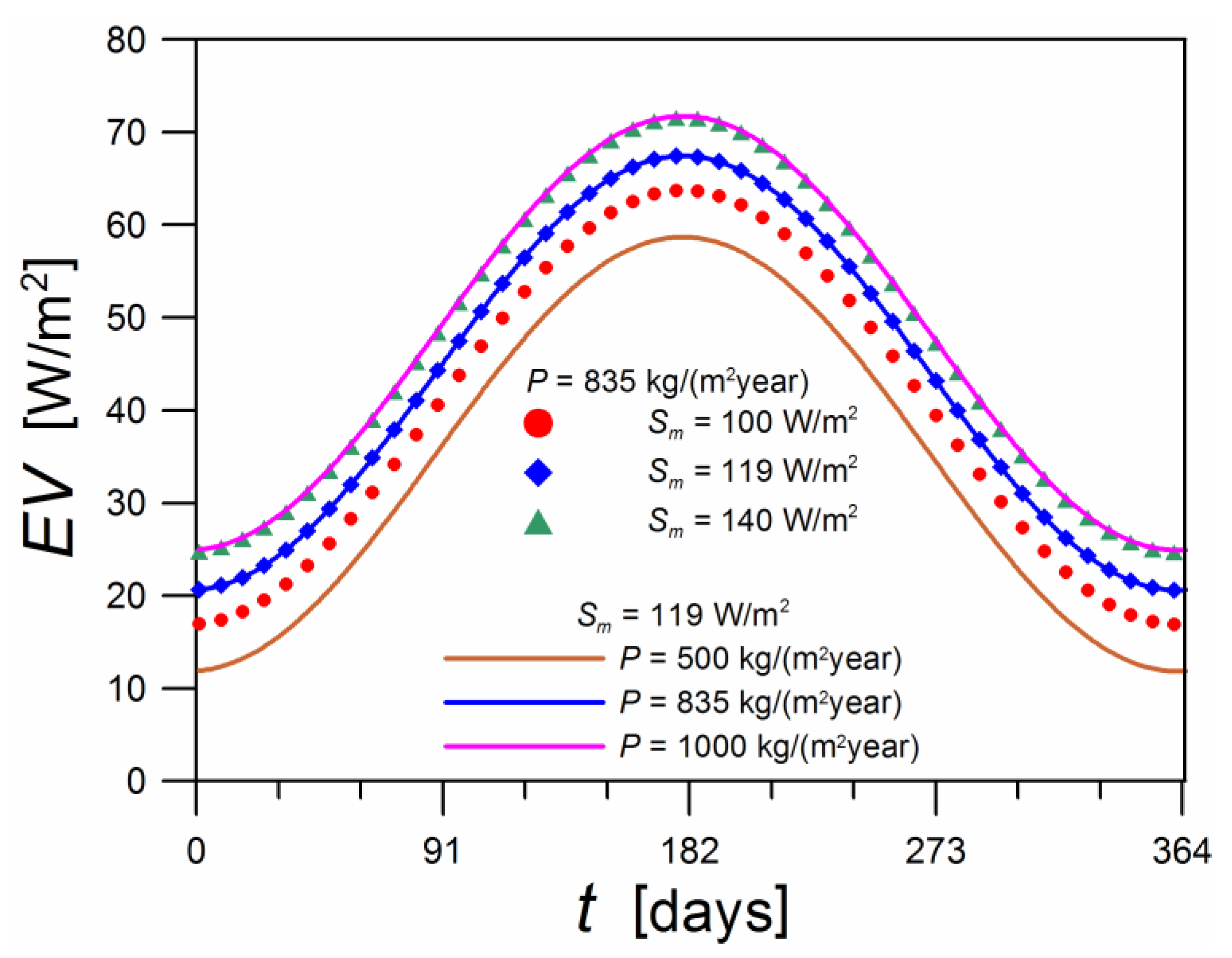
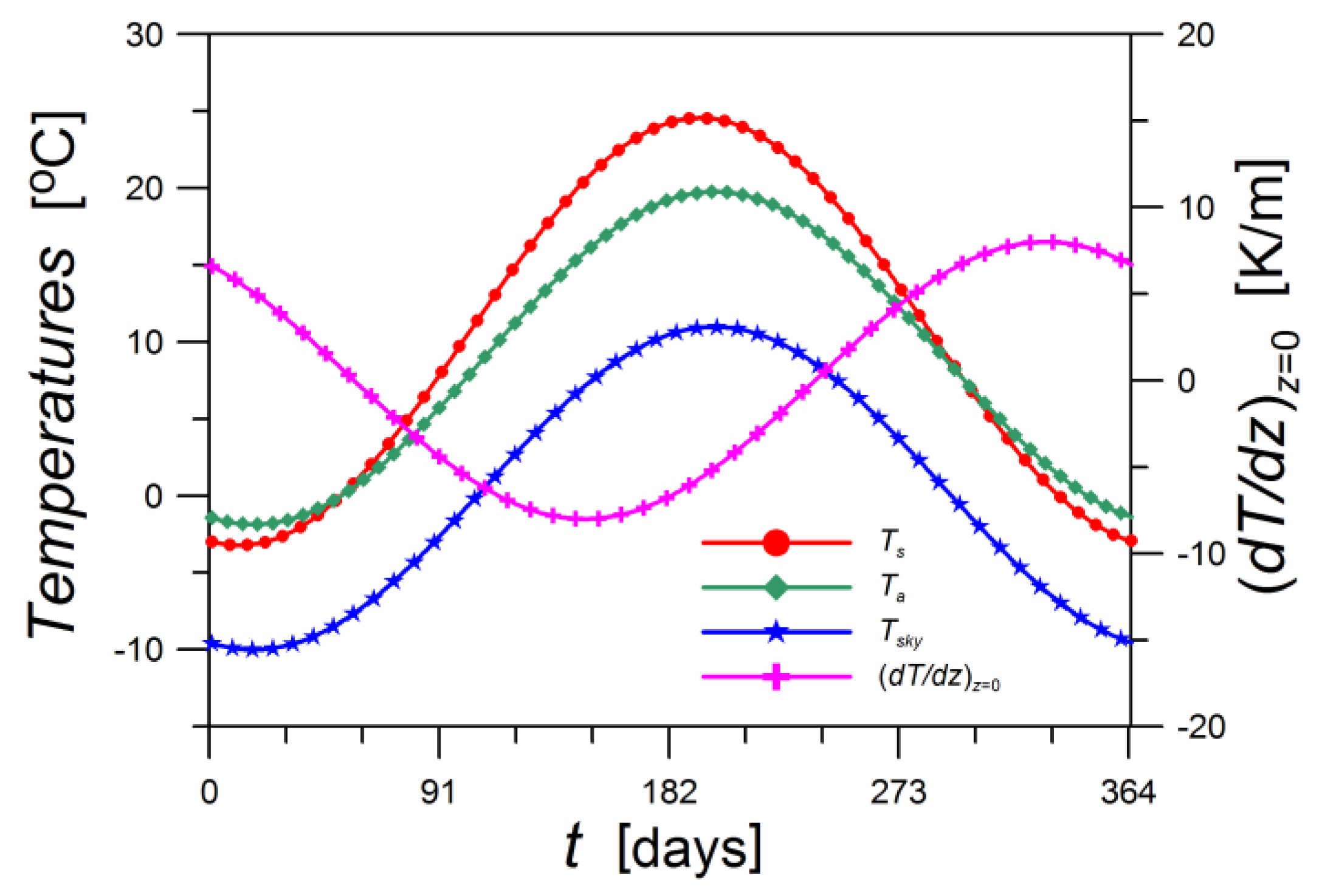
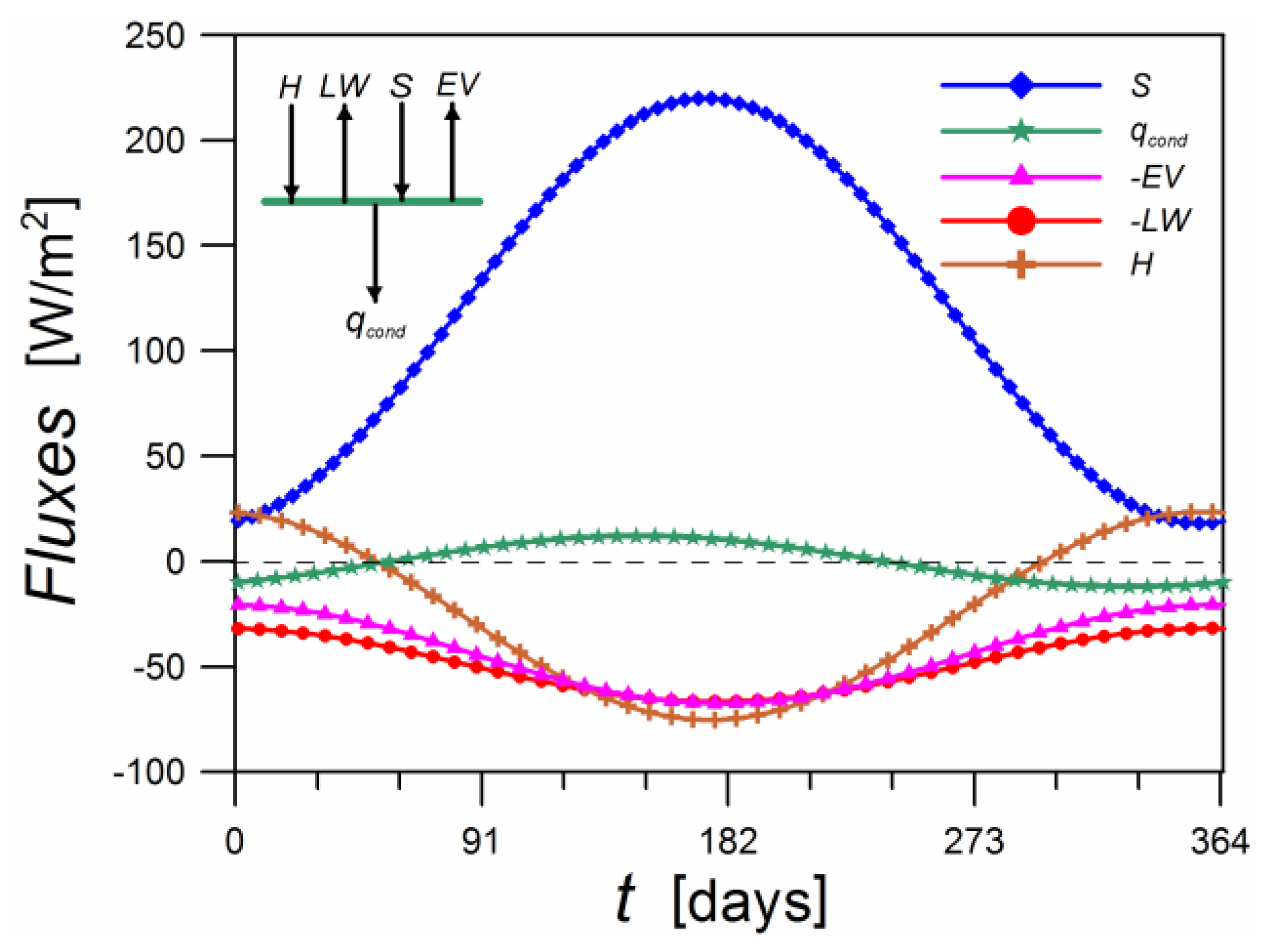



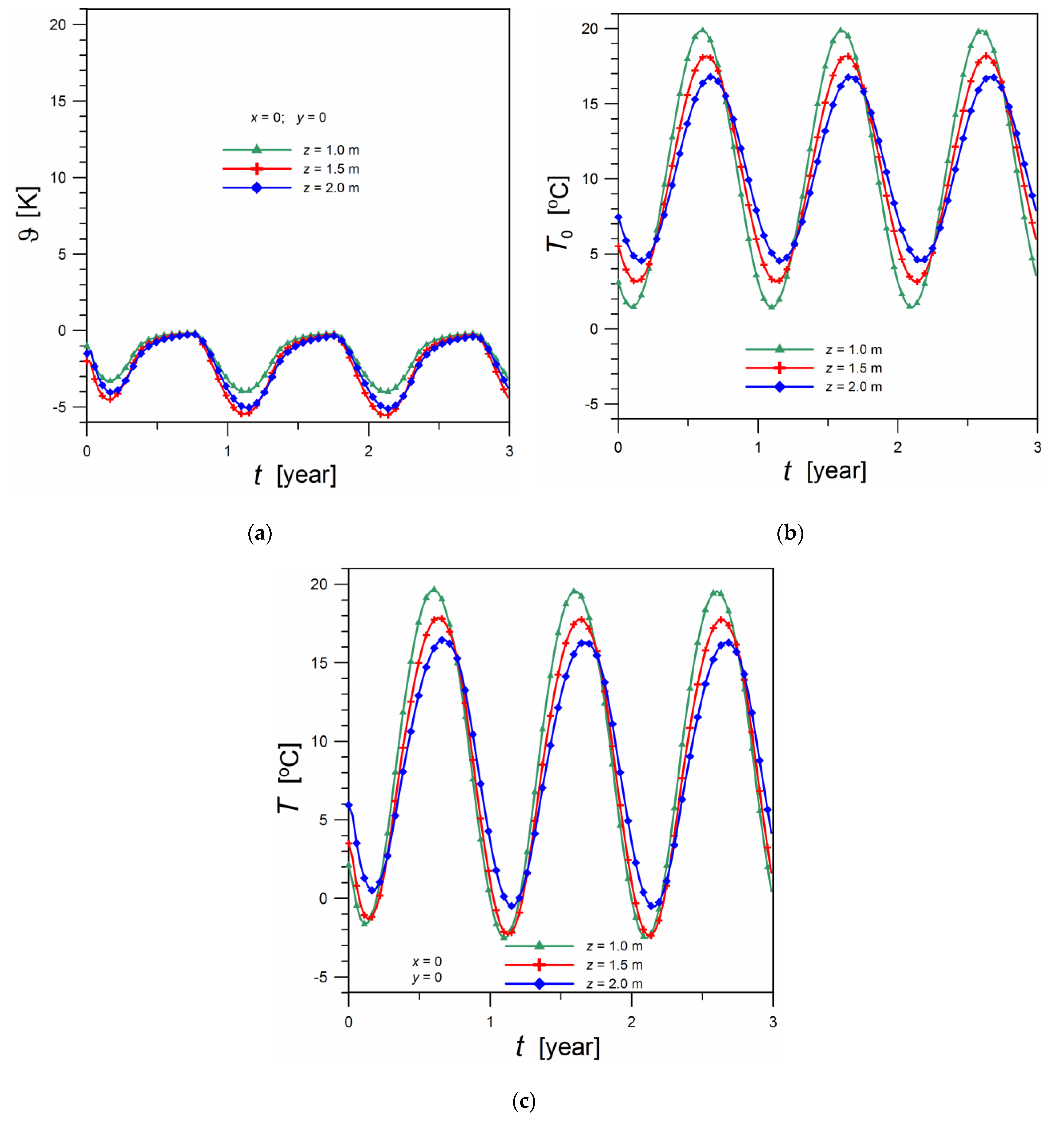
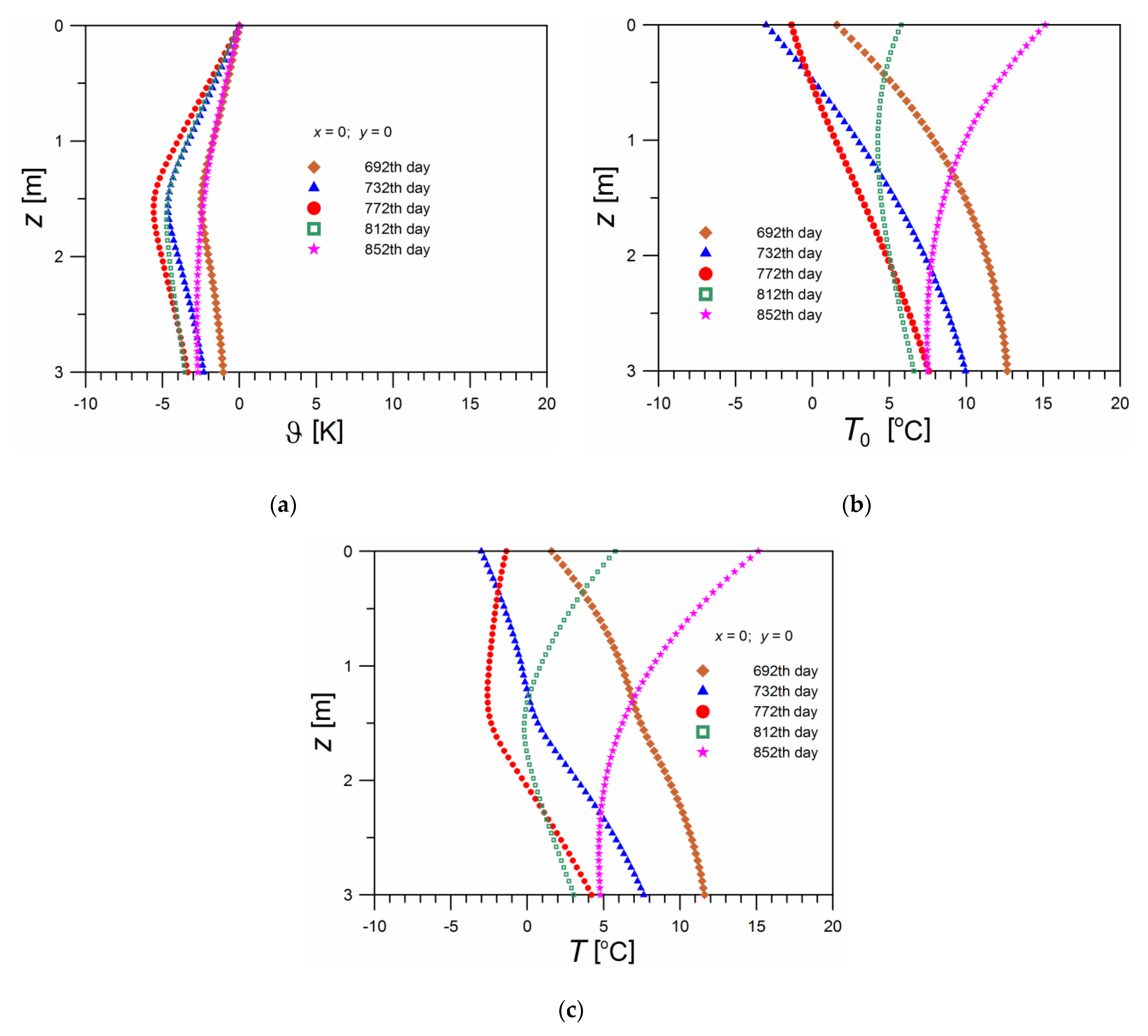
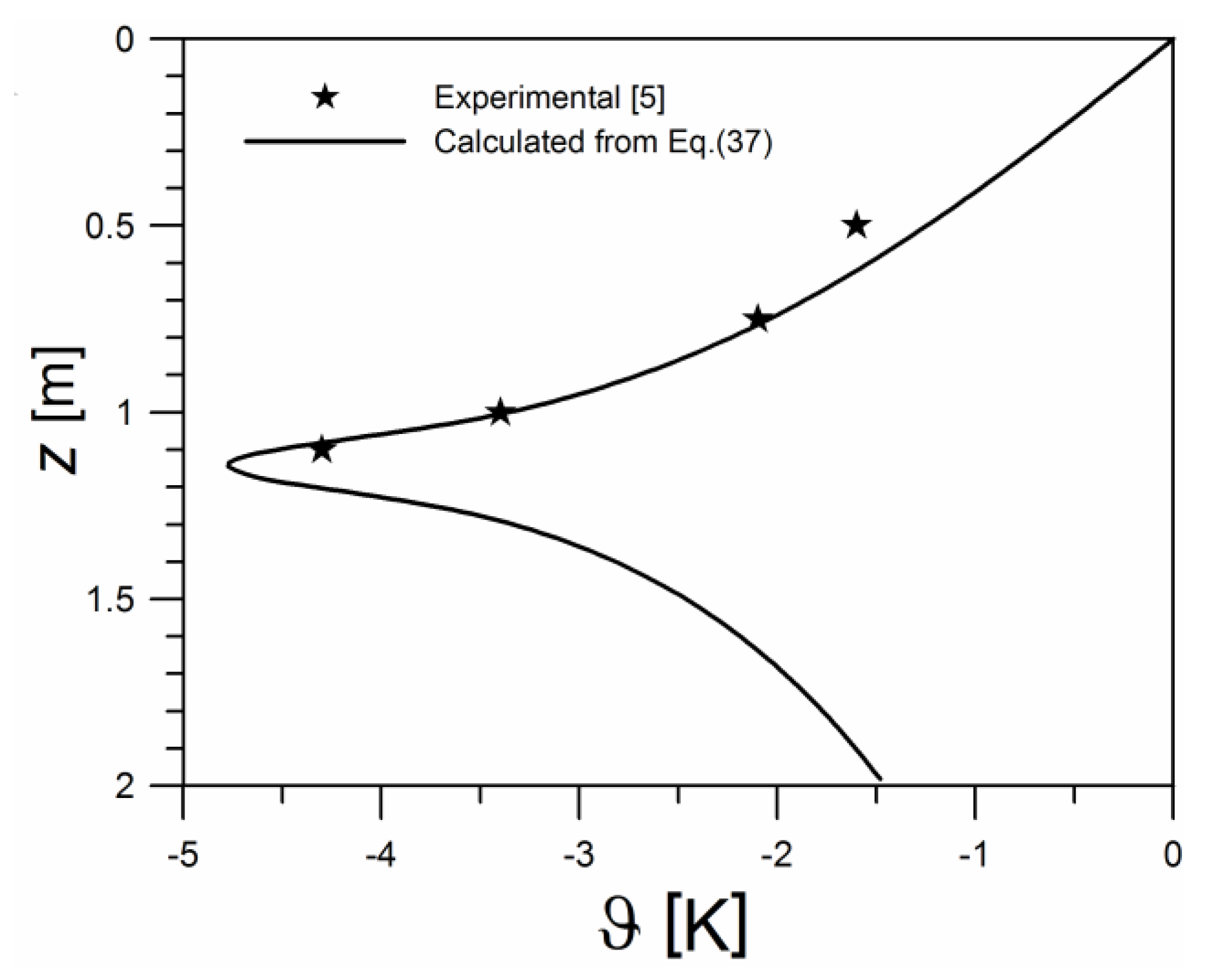
| Quantity | Value | Quantity | Value |
|---|---|---|---|
| Tam | 8.95 °C | RH | 0.758 |
| Aa | 10.81 K | k | 1.50 W/(mK) |
| Pa | 0.300 rad | α | 0.6 × 10−6 m2/s |
| Sm | 119 W/m2 | Levap | 2.47 × 106 J/kg |
| Asol | 101 W/m2 | rc | 70 s/m |
| Psol | −0.153 rad | u | 2.56 m/s |
| P | 835 kg/(m2year) | L | 2.45 m |
| Quantity | Value | Quantity | Value |
|---|---|---|---|
| Nring | 63 | R | 0.5 m |
| number of rows | 7 | p | 1 m |
| Aj | 1.5 m2 | hGHE | 1.5 m |
| qmax | 10 W/m2 | gap | 0.5 m |
| hd | 210 days | k | 1.50 W/(mK) |
| Pa | 0.30 rad | cv | 2.5 × 106 J/(m3K) |
| Q | 113 MJ/(m2year) |
Publisher’s Note: MDPI stays neutral with regard to jurisdictional claims in published maps and institutional affiliations. |
© 2021 by the authors. Licensee MDPI, Basel, Switzerland. This article is an open access article distributed under the terms and conditions of the Creative Commons Attribution (CC BY) license (https://creativecommons.org/licenses/by/4.0/).
Share and Cite
Gwadera, M.; Kupiec, K. Modeling the Temperature Field in the Ground with an Installed Slinky-Coil Heat Exchanger. Energies 2021, 14, 4010. https://doi.org/10.3390/en14134010
Gwadera M, Kupiec K. Modeling the Temperature Field in the Ground with an Installed Slinky-Coil Heat Exchanger. Energies. 2021; 14(13):4010. https://doi.org/10.3390/en14134010
Chicago/Turabian StyleGwadera, Monika, and Krzysztof Kupiec. 2021. "Modeling the Temperature Field in the Ground with an Installed Slinky-Coil Heat Exchanger" Energies 14, no. 13: 4010. https://doi.org/10.3390/en14134010
APA StyleGwadera, M., & Kupiec, K. (2021). Modeling the Temperature Field in the Ground with an Installed Slinky-Coil Heat Exchanger. Energies, 14(13), 4010. https://doi.org/10.3390/en14134010






